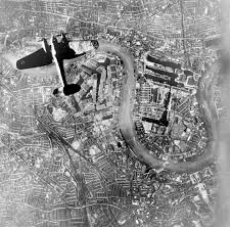

The Blitz
It started August 25, 1940, when a lost German pilot accidentally bombed central London. The British sent a retaliatory bombing strike to Berlin the next night. Hitler issued orders to launch a merciless bombing campaign against London. On September 7, the London Blitz began. Londoners were treated to almost nightly bombing raids by Luftwaffe Heinkel aircraft. The Germans were aided in their targeting with early radar guidance systems, named X-Gerate and Knickebein. On an average night, 200 German bombers would attack, dropping about 300 tons of bombs. Forty thousand British were killed and many historic buildings and cathedrals destroyed.
By mid 1940 Hitler had control over mainland Europe. His next target was Britain. The Blitz was night time bombing raids on British cities, especially London, during the month of September in 1940. The Blitz was a very difficult time for the people of Britain and in London alone nearly 13,000 people were killed. There were a number of reasons for the Blitz. The first being the failure of the Battle of Britain, Hitler thought that if he destroyed the RAF, Britain would no longer have defence against an invasion this invasion was to be Operation Sealion. After the Battle of Britain Hitler realised he could not destroy the RAF meaning Operation Sealion would not work. Hitler's new plan for Britain was the Blitz. Because the Battle of Britain had failed instead Hitler thought that by bombing the British into submission he would then be able to invade them. From November 1940, the Luftwaffe began to concentrate on other British cities. This was an attempt to focus more on damaging British industry. Coventry was hit the worst with over 20 important factories destroyed. As well as factories, railway lines, ports and docks were targeted in hope that without transport the British war effort would fail.
Casualties were high. On the first day of bombing 430 people were killed and 1,600 badly injured. Within a few weeks the daily bombing raids had become nightly raids. Hitler decided to make the bombing raids at night to increase the 'fear factor' and also to make people weaker by not allowing them to sleep properly. People in London slept in underground stations for protection. There were public shelters in most towns, but many people built Anderson shelters in their gardens so that they had protection. Anderson shelters were made out of corrugated iron and were very strong. An air-raid siren warned people when a raid was about to begin. The government tried to confuse the German bombers by enforcing a 'blackout'. Street lamps were switched off, car headlights had to be covered and people had to hang black material in their windows at night so that house lights could not be seen. After May 1941, the bombing raids became less frequent as Hitler turned his attention to Russia. Nevertheless, the effects of the Blitz were devastating. 60,000 people lost their lives, 87,000 were seriously injured and 2 million homes were destroyed.
Image-https://en.wikipedia.org/wiki/The_Blitz

0 Comment:
Be the first one to comment on this article.